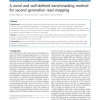291 search results - page 42 / 59 » Progressive multiple sequence alignments from triplets |
BMCBI
2006
13 years 7 months ago
2006
Background: Phylogenetic analyses of protein families are used to define the evolutionary relationships between homologous proteins. The interpretation of protein-sequence phyloge...
BMCBI
2011
12 years 11 months ago
2011
Background: Second generation sequencing technologies yield DNA sequence data at ultra high-throughput. Common to most biological applications is a mapping of the reads to an almo...
BMCBI
2006
13 years 7 months ago
2006
Background: Recent progress in cDNA and EST sequencing is yielding a deluge of sequence data. Like database search results and proteome databases, this data gives rise to inferred...
BMCBI
2006
13 years 7 months ago
2006
Background: When accurate models for the divergent evolution of protein sequences are integrated with complementary biological information, such as folded protein structures, anal...
BMCBI
2005
13 years 7 months ago
2005
Background: Protein sequence motifs are by definition short fragments of conserved amino acids, often associated with a specific function. Accordingly protein sequence profiles de...



